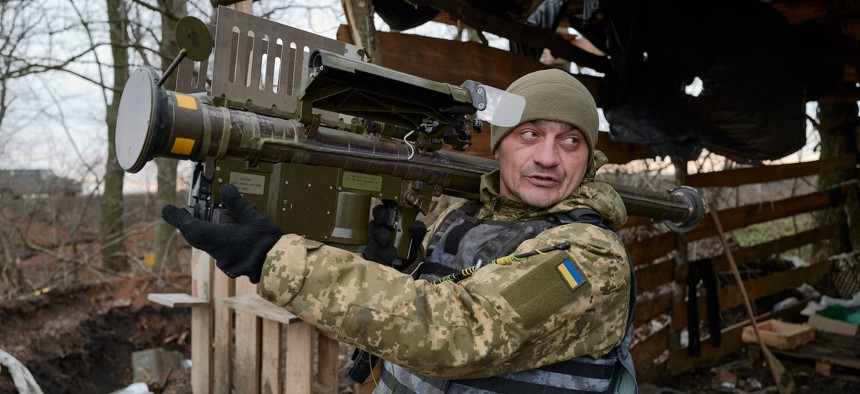
A Ukrainian soldier holds a U.S.-made Stinger air-defense missile in Bakhmut, Ukraine, on December 29, 2022. Getty Images / Pierre Crom
Raytheon still waiting for orders to replace weapons sent to Ukraine
The company has received $2 billion in replenishment orders so far, and expects $2.5 billion more in the next year.
The Pentagon has made a habit of touting high-dollar weapons transfers to war-torn Ukraine, but less of a habit of placing orders to replenish its stockpiles of donated missiles and bombs, senior executives say—despite Congress appropriating funds and giving Pentagon officials special permission to award bulk contracts that span multiple years.
“If you think about this $30-some billion of the weapons that we've supplied to Ukraine, we've only got $2 billion of that under contract today,” RTX CEO Greg Hayes told Defense One in a June interview.
Hayes echoed that sentiment during a quarterly earnings conference call Tuesday, but said he expects some $2.5 billion in replenishment weapons deals over the next 12 months.
The deals are particularly important as the Pentagon pushes defense companies to expand their munitions production to not just replace what has been given to Ukraine, but to further build up U.S. stockpiles.
Raytheon-made weapons have often been hailed as difference-makers on the battlefield. Its Stinger heat-seeking missile and Javelin anti-tank missile, which it manufactures jointly with Lockheed Martin, helped Ukraine blunt the initial Russian invasion. More recently, its NASAMS and Patriot air defenses have been credited with shooting down Russian missiles and drones. The weapons’ success in Ukraine has increased global demand from U.S. allies and partners, RTX executives said.
Top Pentagon officials pushed for lawmakers to approve long-term weapons deals—called multiyear procurement contracts—as a way to more quickly replenish stockpiles while saving taxpayers money. Since the contracts would span several years, they incentivize improving manufacturing facilities and buying raw materials in bulk. The deals not only benefit large firms like RTX, formerly called Raytheon Technologies, but also dozens of smaller companies that are part of the elaborate supply chain.
“The benefit of a multi-year [contract] is it really stabilizes that industrial base,” Wes Kremer, president of RTX’s Raytheon division, which makes all of the company’s missiles and bombs, said in a June interview at the Paris Air Show.
The long-term deals give “small mom and pop companies surety to know that … there's going to be orders for the next five years. Then they can make those business decisions and investments in capacity and quality, and throughput, all of those things that make it better.”
But Hayes said “there was just institutional resistance” within the Pentagon to awarding these long-term deals until lawmakers were able to strike a two-year spending deal in early June.
“Once the debt deal got done, I think you'll see more of those contracts come to fruition,” he said.
But there have still been slow downs. Hayes said RTX asked Pentagon officials to waive the Truth in Negotiations Act, or TINA, provisions, but they have been reluctant.
“Nobody has given us that, so that adds six to nine months … to the procurement process,” he said. “That's … a little frustrating.”
When signing a multiyear deal, a company must show the annual savings that will result. The Congressional Research Service estimates that these long-term contracts save taxpayers 5 to 15 percent. But in some cases, showing savings with some weapons given to Ukraine is difficult. Raytheon has not manufactured Stinger missiles for the U.S. Army in two decades.
“What's that look like on a multi-year?” Hayes said. “All the electronics are obsolete. We're redesigning circuit cards [and] redesigning some of the componentry. That just takes a long time.”
Kremer noted that the company is bringing back retired employees to teach the workers how to assemble the weapon.


